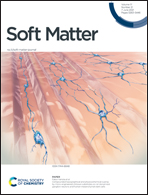Controlling line defects in wrinkling: a pathway towards hierarchical wrinkling structures†
Abstract
We demonstrate a novel approach for controlling the line defect formation in microscopic wrinkling structures by patterned plasma treatment of elastomeric surfaces. Wrinkles were formed on polydimethylsiloxane (PDMS) surfaces exposed to low-pressure plasma under uniaxial stretching and subsequent relaxation. The wrinkling wavelength λ can be regulated via the treatment time and choice of plasma process gases (H2, N2). Sequential masking allows for changing these parameters on micron-scale dimensions. Thus, abrupt changes of the wrinkling wavelength become feasible and result in line defects located at the boundary zone between areas of different wavelengths. Wavelengths, morphology, and mechanical properties of the respective areas are investigated by Atomic Force Microscopy and agree quantitatively with predictions of analytical models for wrinkle formation. Notably, the approach allows for the first time the realization of a dramatic wavelength change up to a factor of 7 to control the location of the branching zone. This allows structures with a fixed but also with a strictly alternating branching behavior. The morphology inside the branching zone is compared with finite element methods and shows semi-quantitative agreement. Thus our finding opens new perspectives for “programming” hierarchical wrinkling patterns with potential applications in optics, tribology, and biomimetic structuring of surfaces.



 Please wait while we load your content...
Please wait while we load your content...